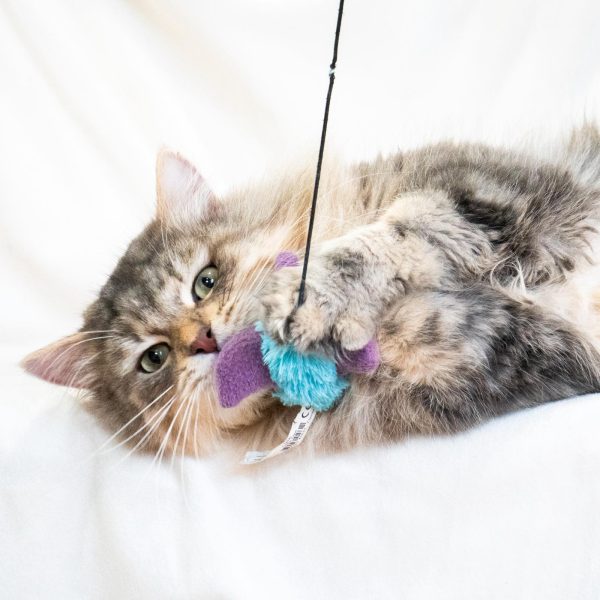TEST Angel of Siberia
You fell in love with a gorgeous little kitty and have decided to adopt the beautiful Princess. Like any new parent, you are overflowing with happiness… when a worrying thought creeps into your mind. Will Princess get along with Queenie, the cat who has shared your life until now? How do you introduce them so that they live together happily? How do you avoid traumatizing your furry sweethearts? How you wish that all goes well and that your cats live in harmony!
Even though some cats meeting for the first time can hit it off right away, often, the sudden arrival of a new cat in a household results in stress, fights, and issues. Following a few simple but crucial steps will allow for easier integration of all Princesses, acceptance by all Queenies, and cohabitation will be peachy. However, the first step is to have the new kitty examined by your veterinarian to make sure it is healthy.


Moving into a new place is always stressful, whatever the species. The difference lies in how this stress is handled, and how long it takes to adapt to the new surroundings and feel comfortable. A cat’s first reaction in the face of any stressful change is to hide. Hiding provides a sense of security, which allows the cat to calm down. From there, the cat can observe its new environment without being seen and establish the best strategy to ‘survive’ this upsetting situation.
The ability to adapt to change varies significantly among individuals. Likewise, for everyone, this ability may vary over time. As we cannot predict how the new cat will react to its new surroundings, we better plan for the worst to avoid unpleasant surprises. The safer the cat feels, the more comfortable it will be, and less likely to hide.
Set up a room for Princess before she arrives. Restricting access to the apartment means limiting the space which the new cat can explore and get used to at first to make it easier to establish new landmarks. However, despite restricting access to the rest of the house, the isolation room must contain EVERYTHING the cat may need. There must be a feeding area, a water bowl or fountain, sturdy places to climb, safe hiding places and a welcoming litter box, away from the food.
The isolation room is NOT a prison, but rather a sanctuary for the new cat, apart from the resident cat. The duration of the isolation period can vary; you want to prevent any contact between Princess and Queenie as long as Princess is not perfectly comfortable in her room, AND Queenie has stopped worrying about what’s going on behind the door of said room. This can take from 14 days to a few weeks, depending on the cat. It is better to take your time since a hasty introduction can lead to problems.
Use this time to get to know your new buddy and bond since you will be visiting the cat every day to feed it, play with it, pet it, give it treats… In the meantime, the cats will be able to smell each other through the door. You can expect some hissing and batting under the door; this is okay. While Princess and Queenie are separated by a door, you do not have to worry about cat fights.


The worst mistake you could make would be to force the cats together before they are ready. You will know Princess is ready when she is happy in her room. Happy cats walk around with their tail and head held high. They come to us, eat with appetite, play, and display healthy behavior. The same applies to Queenie. Before you let your kitties meet, the new cat should discover the rest of the house, without the resident cat being around. To do so, put the latter in a closed room with some tasty treats, and follow these rules:
–The cats must not see each other.
–Exploring the house implies many treats and rewards, for a pleasant association. Let Princess explore until she is once again happy and comfortable. Then, if all goes well, it’s time to take it up a notch.
The introduction technique consists of 3 simple steps. In fact, the process is so simple that people often tend not to do it properly. You, however, will follow them to the letter!
Step #1: Make the cats comfortable without seeing each other. This means an isolation period for the new cat, during which it will get used to its new surroundings and human, without meeting the resident cat. If you have been following our advice up until now, you’re ready for step #2.
Step #2: Prepare a bowl of very yummy food or treats for each cat, making sure that they are hungry at the moment. Open the door ever so slightly so that the cats can see each other without touching. Keep a hand on the door to close it if necessary. A baby gate or screen can also be used. Place one bowl in the new cat’s room first, 1 or 2 meter(s) away from the door, then place the other bowl 1 or 2 meter(s) away on the other side of the door, for the resident cat. If you are not alone, assign one person per cat.
The trick here is to remember the saying ‘when the appetite goes; everything goes’; all is well if both cats eat. Should either snub the food, move the bowls further away until they eat. You can then move the bowls closer to the door.
Repeat at least once or twice a day, moving the bowls closer with each success, as long as both cats eat. What you are seeking to achieve here is to create a pleasant association: when a cat sees the other cat, something good happens (hence why the food or treats must be delicious). Step #2 is over when both cats eat while facing each other through the slightly open door without growling, hissing, or batting.
Step #3:Once the cats eat in front of each other with minimal stress signals, move the bowls back to the starting point and open the door completely. Allow the cats to roam around the house freely, under supervision, offering plenty of treats whenever they cross paths. This will strengthen the pleasant association with the other cat. Put the new cat away in its room when monitoring is impossible (during the night or work hours) to avoid issues. As soon as both cats display minimal stress signals when walking around supervised, official unsupervised cohabitation may begin!


At first, Princess and Queenie may hiss, growl, hit or chase each other. Let them figure out their own living arrangements to avoid future conflicts. Engaging in negotiations over coveted resources and expressing their feelings if the other cat gets in their bubble is normal and healthy, and it can get loud and scary. By interrupting, you are prolonging these necessary negotiations. Should a cat fight seem too intense, DO NOT get between the cats! Instead, toss a cushion near the cats, wait for them to split up and isolate them. When you get them back together, give them both plenty of tasty treats to make them forget about the other cat. If this does not work, isolate them immediately and call us.
While this seems heart-breaking, it’s also possible that Princess may take Queenie’s place. There is no justice or seniority in cats; you will have to let it go. Adult cats vs kittens: Kittens aged 3 to 5 months usually have an easier time adapting to change. This, however, does not guarantee an easy and fast introduction. When introducing cats, you must respect their individual pace. Going through the whole introduction process may take anywhere from a few days to several weeks, regardless of age, sex or breed. The cat that’s slowest to adapt will determine how long it takes. Environmental enrichment is key to avoiding a generational clash between a rambunctious new kitten and a (usually) quieter adult.
Skipping steps, going too fast, putting your emotions before the cats’ needs or failing to see the signs of stress your cats are sending will prevent the positive association you seek to achieve and increase the risks of future conflicts. Taking the necessary time will allow for the relationship between your cats to be built on solid and pleasant grounds.
There will always be some bickering, as the cats will need to adjust their routines and make compromises. However, if the introduction is successful, these negotiations will take place on the basis of tolerance or, sometimes, affection.
Written by Karine Gelinas, Cat Educator and Veterinarian




